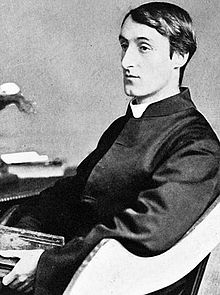Gerard Manley Hopkins
Gerard Manley Hopkins (born July 28, 1844 in Stratford near London , † June 8, 1889 in Dublin ) was a British poet and Jesuit whose poems are mainly admired for the liveliness of their expression.
Life
Hopkins was born in London , but his ancestors came from Wales , and he attended Highgate School . He was the son of an insurance agent and studied at Balliol College of University of Oxford , where he a follower of Edward Bouverie Pusey was and the Oxford Movement joined. It was in Oxford that his friendship with Robert Bridges began , which was to be of great importance for his development as a poet. In 1866 he followed Newman's example and converted to the Roman Catholic Church. He studied theology at St. Beuno's College in Tremeirchion in North Wales. In 1868 he entered the Jesuit order and refrained from writing poetry for seven years. In 1882 he became a teacher at Mount St. Mary's College Sheffield and Stoneyhurst College Lancashire . He later became - as a priest - Professor of Classical Philology at University College Dublin .
Hopkins did not publish any of his poems during his life. It was only because of the efforts of his friend Bridges that his collected poems were published in 1918. These included The Wreck of the Deutschland (written in 1876, referring to the fall of Germany ), The Windhover and Pied Beauty . Today he is one of Britain's most admired poets. He died of typhus in Dublin on June 6, 1889.
The rediscovery of the leap rhythm for English poetry
Its historical significance is largely based on its innovations in poetic form.
Before Hopkins, Middle English and modern English poetry was based on a rhythmic structure derived from the Norman side of English literary heritage. This structure was based on repeated groups of two or three syllables, with the stressed syllable in the same place for each repetition. Hopkins called this regular meter running rhythm . Although he wrote some early verses on the go, he later became fascinated by the older rhythmic structure of the Anglo-Saxon tradition, the most famous example of which is the Beowulf. Hopkins called this rhythmic structure jump rhythm . This jumping rhythm is based on verse feet with a variable number of syllables, usually between one and four per verse foot, whereby the stress always falls on the first syllable of a verse foot.
For Hopkins, the leaping rhythm made it possible to escape the regularity of the running rhythm which, in his view, necessarily had to "lame and tame" poetry written in him. Many contemporary poets followed Hopkins' example, although most of them did not adopt the jump rhythm, but instead gave up traditional rhythmic structures in favor of the free verse .
Hopkins also underpinned his poetry with the concepts of inscape (ingestalt) and instress (in power), with which he tried to express that everything in God's creation has an individual formative power and can thus cast a spell on every viewer. Central themes for him were nature and religion, God and man. Hopkins' poems are still impressive today with their original word creations, often dark metaphors, with a deliberate break in semantics and syntax and, above all, with the new metrics of the jump rhythm.
See also
Works (selection)
English-language original versions:
- The Wreck of the Deutschland ( digitally available online; English)
- God's Grandeur ( Online )
- As Kingfishers Catch Fire ( Online )
- Pied Beauty ( Online )
- Carrion Comfort ( Online )
- The Windhover. To Christ our Lord ( Online )
Bilingual editions (German, English):
- Beloved child of language. Poems . Edition Rugerup , Hörby / Sweden 2009, ISBN 978-91-89034-21-1 . (Translation from English and commentary: Dorothea Grünzweig )
- On the return flight to earth. Gerard Manley Hopkins - an introduction to his poetic world . Lyrik-Kabinett Munich, Inigo Medien & Edition Rugerup, Hörby / Sweden 2009, ISBN 978-39-38776-25-4 . ( Audio book as CD )
- A very skilful translation of the poems by Ursula Clemen and Friedhelm Kemp can be found in an out of print bilingual edition by the Reclam publishing house ( ISBN 3-15-009440-2 ).
literature
- Tom Dunne: Gerard Manley Hopkins. A Comprehensive Bibliography (Oxford, 1969).
- Paddy Kitchen: Gerard Manley Hopkins (New York, 1979).
- Humphrey House and Graham Storey (ed.): The Journals and Papers of Gerard Manley Hopkins (London & New York, 1959).
- Catherine Phillips (ed.): Gerard Manley Hopkins. The Poems with Selections from the Letters and Journals (Oxford, 1986).
- The Poetical Works . Ed. Norman H. MacKenzie (Oxford, 1990).
- RKR Thornton (ed.): All My Eyes See: The Visual World of Gerard Manley Hopkins (Sunderland, 1975).
Web links
- Literature by and about Gerard Manley Hopkins in the catalog of the German National Library
- Arnfrid Astel on Ingestalt and Inkraft at Hopkins
- The first edition of his poems (1918) online (English)
| personal data | |
|---|---|
| SURNAME | Hopkins, Gerard Manley |
| BRIEF DESCRIPTION | British lyric poet and Jesuit |
| DATE OF BIRTH | July 28, 1844 |
| PLACE OF BIRTH | Stratford near London |
| DATE OF DEATH | June 8, 1889 |
| Place of death | Dublin |
